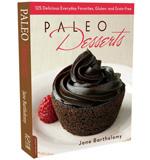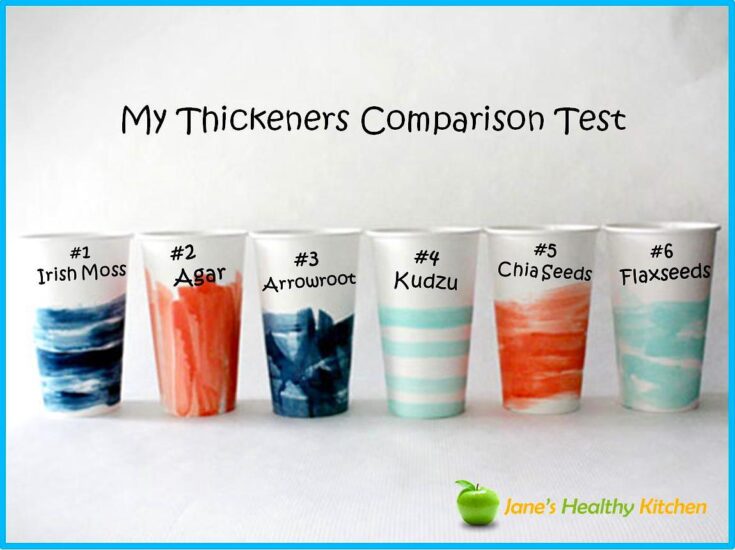By Jane Barthelemy.
This post is for all you mad scientists in the kitchen! Every chef needs to know the best thickeners. When I was writing my Paleo Desserts book I felt like a blind person searching in the dark. My goal was to re-invent recipes for all our favorite sweets with no gluten, grains or refined ingredients. I wanted to know how grain-free cakes could hold together so they don’t crumble. What should I use to thicken the Lemon Bars? How can I make a Paleo Cheesecake so dense that it slices like New York Cheesecake? How much thickener should I use in the Chocolate Mousse? A teaspoon or a gallon?
This called for an organized scientific experiment. Like a mad scientist, I made a list of my 16 thickeners. I decided to test each one both at room temperature and after heating. Soon there were 32 paper cups labeled and arranged in rows on my kitchen counter. Each cup got a tablespoon of the thickener, and 1/4 cup of filtered water. I stirred the first group and left them sitting at room temperature. For the second group, I stirred each one in a pan over low heat until it bubbled for 2 minutes, and then poured it back into the cup. I felt sort of ridiculous doing all this. But I really wanted to know what would happen, and couldn’t begin to write the book without it. Then I went to bed. The next morning I was amazed to see what happened in the cups. It was fascinating! Here are the results:
1. Irish Moss Seaweed, Best Thickener! Raw Irish Moss gets First Prize hands down! The cups were absolutely solid and I could skate on the surface (If I could skate in a cup). The cold and heated versions were equally hard! I was amazed and excited, however there were a few drawbacks to using Irish Moss for the cookbook. The seaweed must first be washed to remove sand, soaked for several hours, and then liquefied in a superblender. I had to order it online as I couldn’t find it anywhere in Portland. Irish Moss is a seaweed often called carrageenan in the food industry, where it is widely used in ice creams, etc. I decided not to use it in the book because of the drawbacks. However I highly recommend Raw Irish Moss if you can find it.
2. Agar agar – Second Prize goes to Agar. The cold Agar didn’t thicken, however the cooked version was hard enough to skate on. It was beautiful, solid, semi-transparent, whitish, with a lovely velvety quality. I tested both agar flakes and agar powder and noticed they hold equally well. Agar flakes are quite expensive in the grocery store. If you order a 1# bag of Agar powder online, you can save a bundle. Just know that the powder has three times the holding power as flakes. If the recipe calls for 3 teaspoons Agar Flakes, you can substitute 1 teaspoon Agar Powder. Most people have never heard of Agar Powder. Since Agar flakes are available in most grocery stores, I decided this would be a good thickener for puddings and cheesecakes.
3. Arrowroot – Third prize! The heated version held REALLY well, almost hard enough to skate on. It was clear and slightly viscous. I decided this would be a good flour substitute for gluten-free, grain-free, Paleo cakes and cookies. Arrowroot is a very fine powder; it can hold the dough together so it doesn’t crumble. I buy it in the Bob’s Red Mill section of any grocery. Arrowroot looks like cornstarch. However it’s a better thickener for sauces and gravies than cornstarch, which is a gmo grain and not Paleo.
4. Kudzu – An excellent thickener. I had never used Kudzu powder, and this was a revelation. I bought Kudzu granules in the grocery store. They have to be ground into a powder in a hand-held coffee grinder. The heated version held very well, similar to arrowroot but not quite as firm. I was impressed. But Arrowroot was clearly a better choice as it comes already ground and holds better. I really like Kudzu, but it didn’t make it into the book.
5. Chia Seeds – An excellent thickener. Chia seeds are amazing. They’re high in Omega-3 oils and I eat them every day. Both cold and heated chia seeds held extremely well. Their viscous granules don’t always fit into the desired texture of elegant desserts. When I blended them in my high-speed blender, they made a firm paste with great holding power for dark desserts like chocolate. But their black color was a bit of a visual drawback. White chia seeds are more beautiful. Chia seeds slowly began to creep into my cooking, and now they’re a kitchen staple!
6. Flaxseed Meal – Very good, viscous holding power. Flaxseeds are in a class by themselves. They are high in Omega-3 oils and the raw freshly ground seeds gave a strong thickening power. Both cold and heated flax held equally well, with a thick, viscous and sticky texture. Problem is that flaxseeds must be used immediately after grinding, or their delicate oils can be unstable and unhealthy. And since they often create free radicals in baking, I use flaxseeds rarely, and only raw, freshly ground.
7. Potato Starch – A good thickener. Potato Starch took 7th place. The heated version was quite firm, but not as strong as Kudzu or Arrowroot. I do not eat nightshades, and my digestion is so much better for it. See my post Beware of Nightshades. This means I avoid potatoes, tomatoes, peppers, and eggplant. And since arrowroot held much better, I had my answer.
8. Cornstarch – A good thickener. My mother used cornstarch for everything so I was familiar with its holding power. Cooked cornstarch held about the same as potato starch. But corn is a grain and it is genetically modified. That’s not Paleo.
9. Blueberry Puree – Very strong binder. I had noticed that my blueberry smoothies always became a solid mass within 2 minutes. Blueberries are high in pectin and acid. These two ingredients interact in jelling. So I made a mental note to use blueberries whenever possible. The result is the amazing Paleo Chocolate Cake and Paleo Chocolate Pudding Cake recipes.
10. Apple Puree – Strong binder. Apples are also high in pectin, and I noticed the apple puree got thicker as it sat. This was a hint for me to use apples to keep baked goods moist, while binding gluten-free flours together at the same time. A good hint!
11. Irish Moss Powder – A weak thickener. I was disappointed in Irish Moss Powder. It didn’t thicken nearly as well as the Raw Irish Moss. The powdered form is more expensive, not easy to find online, and did not thicken as I had hoped.
12. Guar Gum and Xantham Gum – Gummy binders. These are both slimy and viscous thickeners. Guar gum and xanthan gum have almost eight times the water-thickening potency of cornstarch, and they work without heating. Xanthan gum comes from the outer coating of the bacteria Xanthomonas campestris. Guar gum comes from the hull of guar seeds, a legume, and probably not exactly Paleo. Both guar gum and xanthan gum are used as a additives, thickeners, and stabilizers in packaged foods, such as salad dressings and sauces. I have seen them in gluten-free flour mixes. I understand the theory, but wasn’t sure they actually mimic gluten’s stickiness, or really add anything to the holding power in doughs. I did notice that when added to the wet ingredients in cupcakes or cakes, they dome REALLY fast in baking. If you do this, you’ve got to RUSH them into the oven or they’ll fall. That’s a good trick, but risky, and not a thickener, so I decided not to use them.
13. Tapioca starch – Poor holding power. Heated tapioca starch held well, but less than cornstarch or potato starch.
14. Lecithin, Sunflower – No holding power, but a great emulsifier! Lecithin helps liquids and fats to blend together so they are smooth and creamy without separating. Sunflower lecithin is non-gmo and Paleo. However it is rather expensive, so it sits on my pantry shelf and I don’t use it a lot.
15. Lecithin, Non-gmo Soy – No holding power, but this is also a great emulsifier. Non-gmo soy lecithin is widely available but expensive. This also sits in my pantry.
16. Irish Moss dry flakes – No holding power. I bought Irish Moss flakes at my food coop. I was excited to find a local supplier. However they smelled like old rotten fish and didn’t hold at all even when heated. Good-bye!
Conclusion – Whew!
After the test, I decided to use Agar and Arrowroot as the primary thickeners in my Paleo Desserts Cookbook. I also use apple and blueberries whenever possible because of their binding power, nutritional value and delicious flavor!
I’m passing this on in case it’s useful to you other mad scientists in the kitchen. What did I miss? Are there any other thickeners or emulsifiers you’ve tried that you would suggest? Let me know your comments below.





7 Replies to "What are the best healthy thickeners?"
David D. June 25, 2022 (6:46 pm)
Thank you for mentioning GMO corn in the context of cornstarch. Many people do not realize the significance of that.
Conventional corn (i.e., GMO corn) and conventional soy (i.e., GMO soy) means that you are consuming concentrated quantities of the toxic herbicide RoundUp (glyphosate). The crops are genetically modified so that they can tolerate large amounts of RoundUp without dying, which you end up eating. The World Health Organization has labelled RoundUp as “probably carcinogenic”.
A related product to watch out for is high glucose corn syrup (which, of course, is also made from corn). It is ubiquitous in prepared foods, such as soft-drinks and sauces. *Read the ingredients* on everything! I have never seen an ingredient specify non-GMO or organic high glucose corn syrup.
Jane Barthelemy August 31, 2022 (9:24 pm)
Hi David, Thank you for your comment. Yes, you are so right. All the many GMO foods like soy and corn give you a double-whammy of toxins – GMO toxins and an extra helping of Glyphosate. What were they thinking? If The WHO actually pronounced Roundup as “probably carcinogenic”, then we can be 150% sure it’s a terrible killer. Personally I avoid all sweets and all processed foods. I rely on the soil in my garden, and that of the farmers around me, as best I can. Best wishes for your delicious health! Jane
Norm December 16, 2021 (12:00 am)
Jane, where did you come from?
I ABSOLUTELY salute you for giving the Irish Moss the diamond medal as a raw food thickening agent.
Can I invite you to talk with me some sense into the stupid brains of our Australian Tyrants? It is only for the highest bidder on brown envelopes who can import some and then sell it at astronomical prices here in the OiOiOi country.
How I wish to get my hands onto Irish Moss.
Ironically, you’d think a POM would know the Irish but no, they haven’t even heard of. So much to our intelligent health experts running this country into grounds.
You’re my hero, Jane! Forever.
Jane Barthelemy December 16, 2021 (5:24 am)
Dear Norm, You really make me laugh! Thanks so much for making me your hero. That part I accept with glee! But after all that testing was said and done I decided NOT to use Irish Moss in my 2 cookbooks PALEO DESSERTS and GOOD MORING PALEO. Because it is tricky to find in some areas, it varies in quality, and you have to separate out the snarly sand and miscellaneous aquatic debris. Ha Ha! So Irish moss did NOT make it into my recipes. Our challenges are the keys to understanding ourselves. They are precious gems. I hope these little difficulties help you become flexible and unravel the mysterious beauty of life on Earth. Best wishes, Jane
PS. Yes, the whole world is waiting for the Australian government to come to its senses and take care of its beautiful people.
Esther October 2, 2021 (5:26 pm)
Psyllium seed powder is a great thickener for foods you don’t want to heat.
Heather September 11, 2021 (11:14 am)
Thanks for putting in the time and effort so all I have to do is wonder and google!
Jane Barthelemy September 12, 2021 (7:34 am)
Hi Heather, Thanks so much for your comment. It was really fun and exciting to do this experiment. Happy to help! Jane